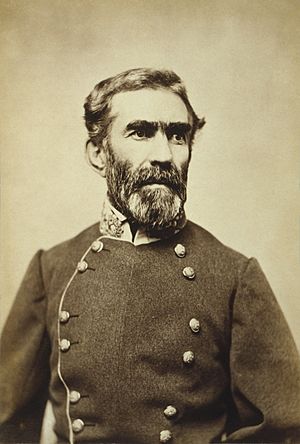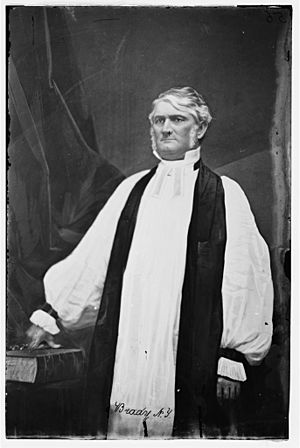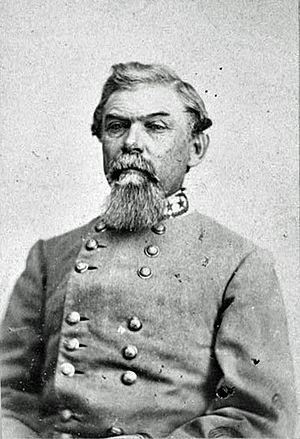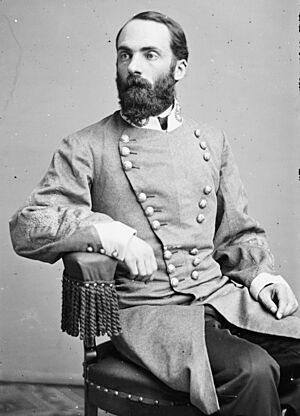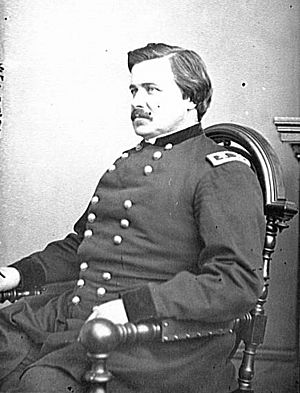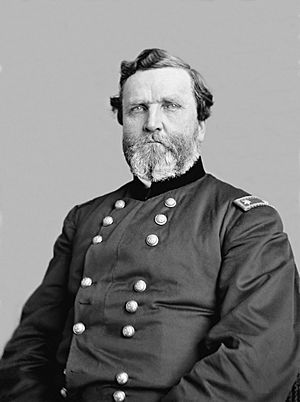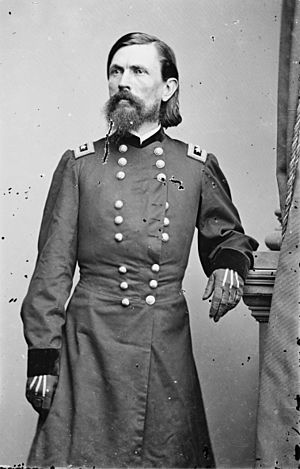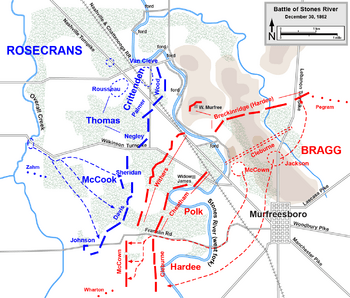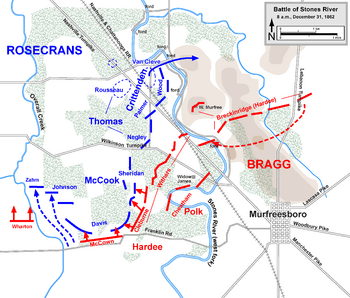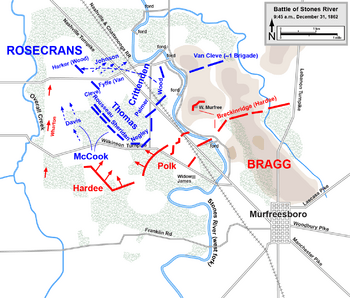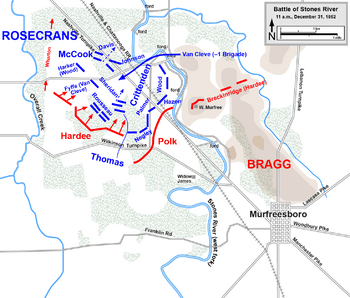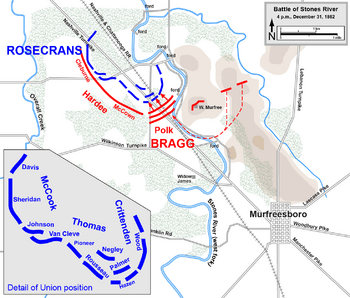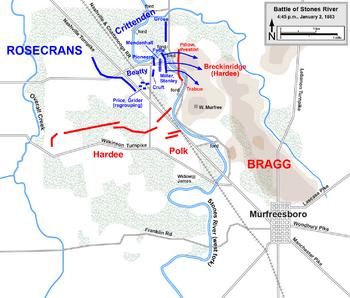Battle of Stones River facts for kids
Quick facts for kids Battle of Stones River |
|||||||
|---|---|---|---|---|---|---|---|
| Part of the American Civil War | |||||||
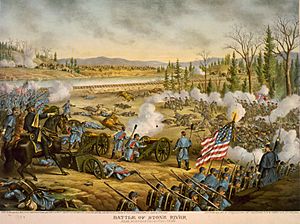 General Rosecrans (left) rallies his troops at Stones River. Illustration by Kurz and Allison (1891). |
|||||||
|
|||||||
| Belligerents | |||||||
| Commanders and leaders | |||||||
| William Rosecrans | Braxton Bragg | ||||||
| Units involved | |||||||
| Army of the Cumberland | Army of Tennessee | ||||||
| Strength | |||||||
| 41,400 effectives | 35,000 effectives | ||||||
| Casualties and losses | |||||||
| 12,906 total 1,677 killed 7,543 wounded 3,686 captured/missing |
11,739 1,294 killed 7,945 wounded 2,500 captured/missing |
||||||
The Battle of Stones River, also called the Second Battle of Murfreesboro, was a major fight in the American Civil War. It happened from December 31, 1862, to January 2, 1863, in Middle Tennessee. This battle was the end of the Stones River Campaign.
It had the highest percentage of soldiers killed or wounded on both sides compared to other big Civil War battles. Even though the battle itself didn't have a clear winner right away, the Union Army stopped two attacks from the Confederates. The Confederates then left the area. This victory really helped the Union's spirits after they lost the Battle of Fredericksburg. It also stopped the Confederates from taking control of Middle Tennessee.
Union Major General William Rosecrans led his Army of the Cumberland from Nashville, Tennessee, on December 26, 1862. His goal was to fight General Braxton Bragg's Army of Tennessee near Murfreesboro, Tennessee. On December 31, both generals planned to attack the other side's right flank. But Bragg attacked first.
A huge attack by Major General William J. Hardee's troops, followed by Major General Leonidas Polk's, pushed back the Union's right side. A strong defense by Brigadier General Philip Sheridan's division helped stop a complete collapse. The Union soldiers then formed a tight defensive line. The Confederates attacked many times but were pushed back. This was especially true in a wooded area called "Round Forest." Bragg tried to keep attacking, but his troops were slow, and their attacks failed.
Fighting started again on January 2, 1863. Bragg ordered his troops to attack a strong Union position on a hill. But the Union had many cannons there. The Confederates were forced back with heavy losses. Rosecrans was getting more soldiers, so Bragg decided to pull his army back on January 3. He retreated to Tullahoma, Tennessee.
Contents
Why the Battle Happened and Who Fought
After the Battle of Perryville in October 1862, Confederate General Braxton Bragg's army left Kentucky. They went back to Harrodsburg, Kentucky. There, another Confederate army joined them. Even with more soldiers, Bragg didn't try to attack again. The Union commander, Major General Don Carlos Buell, also didn't attack Bragg.
Bragg was low on supplies and left Kentucky. He moved his army to Murfreesboro, Tennessee. His army, now called the Army of Tennessee, set up defenses along the Stones River. On December 16, Confederate President Jefferson Davis ordered Bragg to send 7,500 soldiers to help defend Vicksburg, Mississippi. Losing these men was a big problem for Bragg.
Bragg had two main groups of soldiers, led by Major General William J. Hardee and Major General Leonidas Polk. Bragg also had problems with his top generals. They asked President Davis to replace Bragg. But Davis refused.
On the Union side, President Abraham Lincoln was unhappy with General Buell. He replaced him with Major General William Rosecrans. Rosecrans had won battles at Iuka and Corinth. Rosecrans moved his army to Nashville. Washington warned him that he needed to attack Bragg. Rosecrans took his time to get his army ready. He didn't start chasing Bragg until December 26.
While Rosecrans was getting ready, Bragg sent cavalry (soldiers on horseback) to stop Union supplies. One small battle happened at Battle of Hartsville, which was a Union loss. Both sides also sent out cavalry raids, but these didn't change the main battle much.
The Union army marched towards Murfreesboro in three groups. Confederate cavalry under Brigadier General Joseph Wheeler bothered them along the way. Rosecrans had about 41,000 soldiers marching. The three groups were led by Major General Thomas Leonidas Crittenden, Major General Alexander McDowell McCook, and Major General George Henry Thomas.
Murfreesboro and Battle Plans
Murfreesboro was a small town in Tennessee. It was a place where many people supported the Confederacy. Bragg and his soldiers were welcomed there. The area around Murfreesboro was good for farming, so Bragg planned to get supplies for his army there. He also wanted to stop the Union from moving towards Chattanooga, Tennessee.
The battlefield itself wasn't easy to defend. Some parts had thick cedar forests and rocky areas. These made it hard for soldiers and cannons to move. Bragg's soldiers were on the west side of the river. A part of Hardee's group was on the east side. No one built strong defenses.
By December 29, Rosecrans's army arrived near Murfreesboro. By the next day, Rosecrans had about 41,000 soldiers, and Bragg had 35,000. Bragg had an advantage because his cavalry could attack Union supply lines. On December 29, Wheeler's cavalry rode around the Union army. They destroyed supply wagons and captured Union soldiers.
On December 30, the Union army lined up about two miles from Murfreesboro. Both armies were in lines about four miles long. Both generals made similar plans for the next day. They both wanted to attack the enemy's right side, get behind them, and cut off their supplies. Since both plans were the same, the side that attacked first would likely win. Rosecrans told his men to be ready after breakfast. But Bragg ordered an attack at dawn.
Bragg moved most of Hardee's soldiers to his left side for the attack. This left some soldiers in reserve on the east side of the river. Rosecrans planned for his left side to cross the river and attack. This would give them a good spot for cannons. Rosecrans's generals didn't tell each other about all their troop movements.
The armies were very close, only about 700 yards apart. Their bands started playing music against each other. Union bands played "Yankee Doodle," and Confederate bands played "Dixie." Then, one band started "Home Sweet Home," and all the others joined in. Soldiers from both sides sang the song together.
December 31: The First Day of Battle
At dawn on December 31, around 6 a.m., Confederate General William J. Hardee attacked first. He hit the Union's right side. Many Union soldiers were still eating breakfast. About 10,000 Confederates attacked in a huge wave. They pushed back the Union soldiers quickly. Several Union cannons were captured before they could even fire.
Hardee's attack pushed the Union troops back three miles by 10 a.m. They ended up near the railroad and the Nashville Pike. Rosecrans stopped his own planned attack and sent more soldiers to his right side. Rosecrans rode across the battlefield, directing his units. His uniform was covered in blood from his friend, Colonel Julius Peter Garesché, who was killed by a cannonball next to him.
The second Confederate attack came from Polk's soldiers. What saved the Union that morning was Major General Philip Sheridan. He expected an early attack and had his soldiers ready by 4 a.m. Sheridan's men fought hard and slowed the Confederate advance. But they suffered many losses. All three of Sheridan's brigade commanders were killed. More than a third of his men were wounded or killed in four hours of fighting. This area became known as "The Slaughter Pen." By 10 a.m., the Confederates had captured many cannons and Union soldiers.
Two mistakes by the Confederates helped Rosecrans. General Breckinridge, on the east side of the river, didn't realize the Union attack there had been called off. He refused to send soldiers to help the main attack. Also, Bragg got a false report that a strong Union force was moving towards him. He canceled orders for Breckinridge to send help.
By 11 a.m., Sheridan's soldiers ran out of ammunition and pulled back. This created a gap that the Confederates used. But the Union troops regrouped and held the Nashville Pike. They were supported by more soldiers and many cannons. Repeated Confederate attacks on the Union line were stopped by Colonel William Babcock Hazen's soldiers. This happened in a rocky, wooded area called "Round Forest," also known as "Hell's Half-Acre." Hazen's group was the only part of the original Union line that held. Rosecrans's strong leadership helped stabilize the Union line. The new line was shaped like a half-oval, with its back to the river.
Bragg planned to attack the Union left side, where Hazen's soldiers were. He ordered Breckinridge's troops to cross the river, but they moved slowly. By 4 p.m., Breckinridge's first attacks failed. More soldiers arrived, but their attacks also failed. The battle ended around 4:30 p.m.
Bragg's plan had a big problem. His goal was to cut off the Union's supply line. But his attack pushed the Union soldiers to gather at that very spot. This made their defense stronger.
That night, Rosecrans held a meeting with his generals. Some thought the Union army had lost and should retreat. Rosecrans disagreed. General Thomas strongly supported him, saying, "This army does not retreat." They decided to stay and fight. This decision boosted the soldiers' morale.
Bragg, on the other hand, was sure he had won. He thought the Union had lost more soldiers. He sent a message to Richmond, saying, "God has granted us a happy New Year."
January 1–3: The Final Days
At 3 a.m. on January 1, 1863, Rosecrans went back to his original plan. He ordered soldiers to cross the river and take a hill. This hill would be a good place for cannons. The day was mostly quiet as both armies rested and cared for their wounded.
Wheeler's cavalry kept bothering the Union supply line. They attacked convoys of wounded soldiers. Wheeler thought these movements meant the Union was retreating. He told Bragg this. Bragg, thinking he had won, waited for Rosecrans to leave.
At 4 p.m. on January 2, Bragg ordered Breckinridge's soldiers to attack the hill on the east side of the river. Breckinridge thought it was a bad idea but attacked anyway. The Union soldiers were pushed back across McFadden Ford. But the Confederate attack ran into heavy fire from many Union cannons. Captain John Mendenhall placed his cannons perfectly. They fired on the Confederates, stopping their attack. The Confederates lost over 1,800 soldiers in less than an hour. A Union counterattack pushed the Confederates back. Breckinridge was very sad about the losses. He lost almost a third of his Kentucky soldiers.
On the morning of January 3, a large supply train and more Union soldiers reached Rosecrans. Wheeler's cavalry tried to capture the ammunition train but failed. Later that evening, the Union attacked the Confederate line. They drove the Confederates from their positions. Even with this, the main battle is usually considered to have ended on January 2.
Bragg knew Rosecrans wasn't going to retreat. He also knew that freezing rain could make the river rise and split his army. So, starting at 10 p.m. on January 3, he pulled his army back. He retreated through Murfreesboro and headed south to Tullahoma, Tennessee. Rosecrans took over Murfreesboro on January 5. He didn't chase Bragg. Rosecrans later said, "Bragg's a good dog, but Hold Fast's a better."
Aftermath of the Battle
The Battle of Stones River had many casualties. About 24,645 soldiers were killed or wounded. The Union lost 12,906, and the Confederates lost 11,739. This was the highest percentage of killed and wounded in any major Civil War battle. Four generals were killed or badly wounded.
The battle didn't have a clear winner on the battlefield. But Rosecrans claimed victory because Bragg's army left first. Bragg was criticized by many Confederate generals. Only the support of General Joseph E. Johnston and President Jefferson Davis saved his job.
Stones River was a very important victory for the Union. President Abraham Lincoln wrote to Rosecrans, saying, "You gave us a hard-earned victory, which had there been a defeat instead, the nation could scarcely have lived over." The Confederate threat to Kentucky and Middle Tennessee was gone. Nashville was safe as a major Union supply base for the rest of the war.
Rosecrans spent the next five and a half months strengthening Murfreesboro. A huge fort, "Fort Rosecrans," was built there. It was used as a supply base for the rest of the war. The next big military action didn't happen until June. That's when Rosecrans finally moved his army against Bragg again.
Today, part of the Battle of Stones River site is a national park called Stones River National Battlefield. It has the oldest Civil War monument still standing. It was built by William Hazen's soldiers at Hell's Half Acre. The park also includes Stones River National Cemetery, with over 6,000 Union graves.
Images for kids
-
Maj. Gen. William S. Rosecrans, USA -
Maj. Gen. Alexander M. McCook, USA -
Maj. Gen. George H. Thomas, USA -
Maj. Gen. Thomas L. Crittenden, USA -
Gen. Braxton Bragg, CSA -
Maj. Gen. Leonidas Polk, CSA


